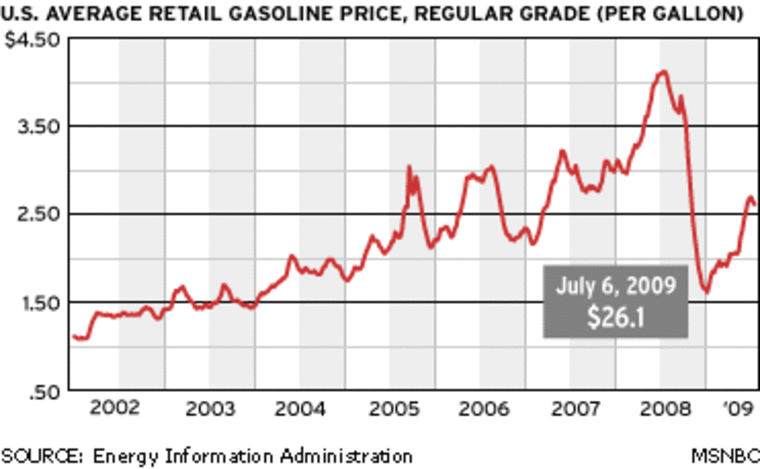If all goes well, pump prices may have peaked for the summer. But with gasoline supplies tighter this month than they’ve been in years, traders and analysts say it won’t take much to send pump prices higher again.
The latest weekly report from the Department of Energy shows gasoline prices continuing to drop. On Monday, the nationwide average price of a gallon of regular unleaded fell another 2.3 cents a gallon to $2.959, after peaking at $3.218 a gallon during the week of May 21. Pump prices are about 2.5 cents higher than this time last year and remain well above $3 a gallon in many parts of the country.
Traders in the futures markets are also betting on a gradual easing of prices in coming weeks. Gasoline futures for August are down more than 15 cents from peak levels in May.
This spring’s pump price spike drew widespread ire from American drivers. A survey conducted earlier this year, as the price of gasoline broke through $3 a gallon, found that more consumers were concerned about high gas prices than they were about terrorism or the state of overall economy.
But that concern has not put a crimp in consumption. Demand has been rising steadily since a seasonal low in late January, and is running a bit stronger than this time last year. Though July 4th falls in the middle of the week this year, high pump prices haven’t cut into travel plans; a record number of Americans plan to hit the road this week, according to a AAA telephone survey. Some 41.1 million people are expected to travel during the July 4 week, up a little less than one percent from last year.
With demand showing no signs of easing, the outlook for gas prices for the rest of the summer depends heavily on whether refiners can crank out enough fuel to meet that strong demand.
So far this year, refiners have fallen behind the curve as they tried to stockpile supplies to gear up for the seasonal summer surge in demand. Thanks to a series of unplanned outages and longer-than-expected maintenance shutdowns, gasoline stocks have been well below their five-year average since April.
"Our seasonal refinery patterns are changing,” said Tim Evans, energy analyst at Citigroup Global Markets. “In the past, we may have seen peak refinery output in the lead-up to summer. Now we'll likely be seeing peak refinery activity during peak demand."
Oil refineries historically have run at something like 95 percent of capacity at this time of year. But as of last week, output was just under 90 percent. With demand running strong and production below normal, refiners have been struggling to keep stockpiles from shrinking further. Last week, the Energy Department that gasoline inventories dropped 700,000 barrels in the week ended June 22, when analysts had been looking for a gain of about 1 million barrels.
Distributors have been making up some of the shortfall with imports. Shipments of gasoline produced offshore have nearly tripled in the past decade, with much of the supply coming from European refiners including the U.K. and the Netherlands. Imports rose sharply this spring, peaking at 1.5 million barrels a day in June before falling back a bit in recent weeks.
Some of the slowdown in production was the result of maintenance and other seasonal downtime that took longer than usual. Refiners have also been installing new equipment to meet tougher clean air standards. Refiners are adhering to tighter safety procedures following the 2005 explosion at a BP refinery in Texas City that killed 15 people, according to some analysts. And the industry has had its share of weather-related shutdowns. A 112,000 barrel-per-day refinery in Coffeyville, Kan., was shut down over the weekend after heavy rains caused widespread flooding in the area.
Despite the setbacks, a number of refineries are coming back online this week, which should help increase production.
A half dozen oil refineries, representing more than 3 percent of U.S. capacity, were set to start up this week, according to a recent survey by Reuters. That should help build stockpiles and take some of the pressure off prices.
A resurgence in severe hurricanes, which in past summers have thrown major crimps in gasoline supplies and sent prices surging, could also derail the inventory build-up. The National Oceanic and Atmospheric Administration is predicting above-normal hurricane activity this year.
Even if pumps prices do move higher on the next six to eight weeks, drivers can look forward to a break later in the year. Barring a major supply hit, prices historically have fallen steadily after Labor Day, as the summer driving season winds down.
“It’s quite easy to predict the last 90 days of the year: we’re going drop off a cliff,” said Tom Kloza, president of the Oil Price Information Service. “That’s a no-brainer.”
